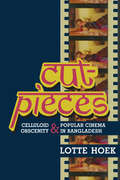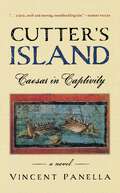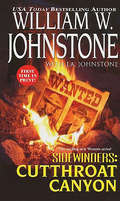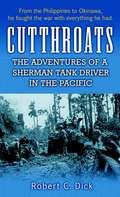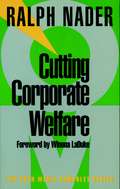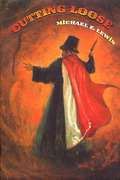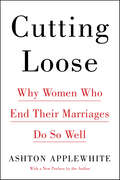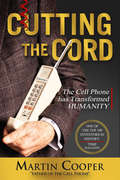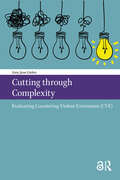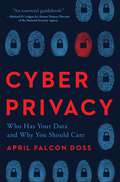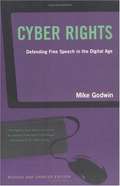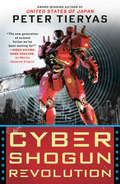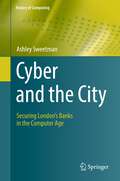- Table View
- List View
Cut-Pieces
by Lotte HoekImagine watching an action film in a small-town cinema hall in Bangladesh, and in between the gun battles and fistfights, a short pornographic clip appears. This is known as a cut-piece, a strip of locally made celluloid pornography surreptitiously spliced into the reels of action films in Bangladesh. Exploring the shadowy world of these clips and their place in South Asian film culture, Lotte Hoek builds a rare, detailed portrait of the production, consumption, and cinematic pleasures of stray celluloid.Hoek's innovative ethnography plots the making and reception of Mintu the Murderer (2005), a popular, Bangladeshi B-quality action movie and fascinating embodiment of the cut-piece phenomenon. She begins with the early scriptwriting phase and concludes with multiple screenings in remote Bangladeshi cinema halls, following the cut-pieces as they appear and disappear from the film, destabilizing its form, generating controversy, and titillating audiences. Hoek's work shines an unusual light on Bangladesh's state-owned film industry and popular practices of the obscene. She also reframes conceptual approaches to South Asian cinema and film culture, drawing on media anthropology to decode the cultural contradictions of Bangladesh since economic liberalization.
Cut-Pieces: Celluloid Obscenity and Popular Cinema in Bangladesh (South Asia Across the Disciplines)
by Lotte HoekImagine watching an action film in a small-town cinema hall in Bangladesh, and in between the gun battles and fistfights a short pornographic clip appears. This is known as a cut-piece, a strip of locally made celluloid pornography surreptitiously spliced into the reels of action films in Bangladesh. Exploring the shadowy world of these clips and their place in South Asian film culture, Lotte Hoek builds a rare, detailed portrait of the production, consumption, and cinematic pleasures of stray celluloid.Hoek's innovative ethnography plots the making and reception of Mintu the Murderer (2005, pseud.), a popular, Bangladeshi B-quality action movie and fascinating embodiment of the cut-piece phenomenon. She begins with the early scriptwriting phase and concludes with multiple screenings in remote Bangladeshi cinema halls, following the cut-pieces as they appear and disappear from the film, destabilizing its form, generating controversy, and titillating audiences. Hoek's work shines an unusual light on Bangladesh's state-owned film industry and popular practices of the obscene. She also reframes conceptual approaches to South Asian cinema and film culture, drawing on media anthropology to decode the cultural contradictions of Bangladesh since the 1990s.
Cutter's Island: Caesar in Captivity
by Vincent Panella&“This vivid short novel . . . of Caesar&’s youthful adventure. . . . Matches the film Gladiator in its vigorous, viscerally affecting depiction of ancient Rome.&” —Publishers Weekly Most of us are familiar with the Caesar of Shakespeare and Shaw. We know him primarily as the manipulative warlord and statesman. But what about the Caesar of Plutarch and Suetonius—historians who dealt with Caesar as a young man? Here, in this stunning novel, written with all the excitement and eloquence of an epic poem, we find Caesar at the age of twenty-five captured by pirates as he sails to the Island of Rhodes to study rhetoric with the renowned Apollonias Moon. &“An alternately rousing and touching adventure tale that offers an intriguing glimpse into the future dictator's psyche...[and] a panoramic view of Rome. . . . Stirring.&” —Booklist &“ . . . A lyric, swift and moving, swashbuckling tale&” —Robert Fagles, award-winning translator of The Iliad &“Cutter&’s Island is a perfect flawless gem, without a false note anywhere.&” —Steven Pressfield, author of Gates of Fire
Cutthroat Canyon: Cutthroat Canyon (Sidewinders #3)
by William W. Johnstone J.A. JohnstoneRollicking Western adventure featuring two hardheaded cowboys who veer towards the wrong side of the law by the authors of the Last Gunfighter series.Here&’s Your Gold. Now Fight for It . . . Sometimes, it&’s bad to be good. That&’s what happens when Scratch Morton and Bo Creel are rewarded with a gold mine for saving a rich man&’s bacon. The catch: this mine is a magnet for marauding Mexican banditos. Budding capitalists, Scratch and Bo fight back. That&’s when they discover that the thieves aren&’t who they thought they were, some really bad guys are on the way, and a beautiful woman might just be the most dangerous bandit of all—the kind that can steal your heart. For Scratch and Bo, this gold mine might make them rich. But it&’s more likely to get them killed—just as soon as they can figure out who wants them dead . . . Praise for the novels of William W. Johnstone &“[A] rousing, two-fisted saga of the growing American frontier.&”—Publishers Weekly on Eyes of Eagles &“There&’s plenty of gunplay and fast-paced action.&”—Curled Up with a Good Book on Dead Before Sundown
Cutthroats (A Slash and Pecos Western #1)
by William W. Johnstone J.A. JohnstoneJOHNSTONE. KEEPING THE WEST WILD.Not every Western hero wears a white hat or a tin star. Most of them are just fighting to survive. Some of them can be liars, cheaters, and thieves. And then there’s a couple of old-time robbers named Slash and Pecos . . . Two wanted outlaws. One hell of a story.After a lifetime of robbing banks and holding up trains, Jimmy “Slash” Braddock and Melvin “Pecos Kid” Baker are ready to call it quits—though not completely by choice. Sold out by their old gang, Slash and Pecos have to bust out of jail and pull one last job to finance their early retirement . . .The target is a rancher’s payroll train. Catch is: the train is carrying a Gatling gun and twenty deputy US marshals who know they’re coming. Caught and quickly sentenced to hang, their old enemy—the wheelchair-bound, bucket of mean, Marshal L.C. Bledsoe—shows up at the last minute to spare their lives. For a price. He’ll let them live if they hunt down their old gang, the Snake River Marauders. And kill those prairie rats—with extreme prejudice . . .
Cutthroats: The Adventures of a Sherman Tank Driver in the Pacific
by Robert DickSoon after we landed it became apparent that there was more than enough artillery here, that the enemy were excellent shots, and that their ammo supply seemed to be endless. With the Japanese deeply entrenched and determined to die rather than surrender, Robert Dick and his fellow soldiers quickly realized that theirs would be a war fought inch by bloody inch and that their Sherman tanks would serve front and center. As driver, Dick had to maneuver his five-man crew in and out of dangerous and often deadly situations. Whether crawling up beaches, bogged down in the mud-soaked Leyte jungle, or exposed in the treacherous valleys of Okinawa, the Sherman was a favorite target. A land mine could blow off the tracks, leaving its crew marooned and helpless, and the nightmare of swarms of Japanese armed with satchel charges was all too real. But there was a war to be won, and Americans like Robert Dick did their jobs without fanfare, and without glory. This gripping account of tanker combat is a ringing testament to the awe-inspiring bravery of ordinary Americans.
Cutting Along the Color Line: Black Barbers and Barber Shops in America
by Quincy T. MillsToday, black-owned barber shops play a central role in African American public life. The intimacy of commercial grooming encourages both confidentiality and camaraderie, which make the barber shop an important gathering place for African American men to talk freely. But for many years preceding and even after the Civil War, black barbers endured a measure of social stigma for perpetuating inequality: though the profession offered economic mobility to black entrepreneurs, black barbers were obliged by custom to serve an exclusively white clientele. Quincy T. Mills traces the lineage from these nineteenth-century barbers to the bustling enterprises of today, demonstrating that the livelihood offered by the service economy was crucial to the development of a black commercial sphere and the barber shop as a democratic social space. "Cutting Along the Color Line" chronicles the cultural history of black barber shops as businesses and civic institutions. Through several generations of barbers, Mills examines the transition from slavery to freedom in the nineteenth century, the early twentieth-century expansion of black consumerism, and the challenges of professionalization, licensing laws, and competition from white barbers. He finds that the profession played a significant though complicated role in twentieth-century racial politics: while the services of shaving and grooming were instrumental in the creation of socially acceptable black masculinity, barbering permitted the financial independence to maintain public spaces that fostered civil rights politics. This sweeping, engaging history of an iconic cultural establishment shows that black entrepreneurship was intimately linked to the struggle for equality.
Cutting Corporate Welfare (Open Media Series)
by Winona Laduke Ralph NaderIn this groundbreaking pamphlet, based on testimony he delivered before Congress, Ralph Nader describes how corporations are picking our pockets, and what we can do to stop them.While the United States continues to experience unprecedented cuts in social service programs and millions of Americans go without health insurance, massive corporations continue to reap huge sums of taxpayer money through "corporate welfare"--corporate subsidies, bailouts, giveaways, and tax escapes. Cutting Corporate Welfare details numerous appalling examples of corporate welfare, including: the giveaway of the public airwaves, which by definition belong to the people, to private radio and television stations (including the latest $70 billion gift of the digital spectrum); taxpayer subsidies for giant defense corporation mergers and commercial weapons exports to governments overseas; and the practice of making patients pay twice for drugs--first, as taxpayers subsidize the drugs' development, and again, as patients, after the federal government gives monopolistic control over the chemical's manufacture to a price-gouging drug company. Cutting Corporate Welfare sounds a wake-up call for those concerned about how we are being pick-pocketed by big business, and what we can do to stop it.
Cutting Loose
by Michael Z. Lewin"Show some respect, young man...Just what was this young woman to you?" Jackie looked into the nurse's pinkface. "Nance was the best friend I ever had," she said. "The only friend I ever had."Jackie is Jack Cross to everyone except Nance, a Wild West show trick shooter in turn-of-the-century New York who has her own secrets to hide. A slick-fielding second baseman with a good bat, Jackie must never drop her disguise if she is to continue to play professional baseball. But when Nance is murdered by a knife-thrower who does know Jackie's secret, the young ballplayer takes off on a transatlantic chase that changes her life.Set on two continents, in three different time-periods, with a fascinating cast of characters including Buffalo Bill Cody, Jack the Ripper, and a musical star named Ruby the Red who has still another hidden life, Cutting Loose is a multi-layered page-turner filled with insights and surprises.
Cutting Loose: Why Women Who End Their Marriages Do So Well
by Ashton ApplewhiteFor women contemplating divorce or for those who have already divorced, Ashton Applewhite’s insightful book sheds light on what to consider before making the decision to end your marriage, how to protect yourself—both financially and emotionally—and how much your life will change.One out of every two modern marriages ends in divorce, and 75 percent of those divorces are initiated by wives. Author Ashton Applewhite is one of these women, having sued for divorce after enduring an unfulfilling ten-year marriage. Cutting Loose is an essential resource for women who want to leave their marriage but fear the consequences.Shattering the media-generated image of the lonely, deprived and financially strapped divorcee, Applewhite provides a much needed reality check. Cutting Loose introduces 50 women, varying in age, race, class and predicament, who have thrived after initiating their own divorces. Their fears of financial, emotional and romantic ruin were never realized; on the contrary, their lives improved immeasurably, and their self-esteem soared.Cutting Loose also answers the crucial questions: How do you finally decide to make the big break? What is getting divorced really like? What are the shortcomings of the legal process? What about custody and child support? Financial and emotional survival? And how does a woman's self-image change during and after divorce? "Ending any kind of oppression takes belief in self. Cutting Loose offers moving evidence of how such belief works, whether in a relationship or walking the road alone. Perceptive, realistic, and wise, the book is of enormous practical value to both women and men who aspire to more equal and fulfilling relationships."—Laura Day, author of Practical Intuition
Cutting a Figure: Fashioning Black Portraiture
by Richard J. PowellExamining portraits of black people over the past two centuries, Cutting a Figure argues that these images should be viewed as a distinct category of portraiture that differs significantly from depictions of people with other racial and ethnic backgrounds. The difference, Richard Powell contends, lies in the social capital that stems directly from the black subject's power to subvert dominant racist representations by evincing such traits as self-composure, self-adornment, and self-imagining. Powell forcefully supports this argument with evidence drawn from a survey of nineteenth-century portraits, in-depth case studies of the postwar fashion model Donyale Luna and the contemporary portraitist Barkley L. Hendricks, and insightful analyses of images created since the late 1970s. Along the way, he discusses major artists-- such as Frédéric Bazille, John Singer Sargent, James Van Der Zee, and David Hammons--alongside such overlooked producers of black visual culture as the Tonka and Nike corporations. Combining previously unpublished images with scrupulous archival research,Cutting a Figure illuminates the ideological nature of the genre and the centrality of race and cultural identity in understanding modern and contemporary portraiture.
Cutting for Sign
by William LangewiescheWith the demise of the Berlin Wall and the Iron Curtain, there remains no more potent--or notorious--political border than the 1,951-mile division between the US and Mexico. Langewiesche shows us how a simple line--a legalism across the land--is also a mirror that reflects our ideals and fears.
Cutting the Cord: The Cell Phone has Transformed Humanity
by Martin CooperOne of Time Magazine&’s Top 100 Inventors in History shares an insider&’s story of the cellphone, how it changed the world—and a view of where it&’s headed. While at Motorola in the 1970s, wireless communications pioneer Martin Cooper invented the first handheld mobile phone. But the cellphone as we know it today almost didn&’t happen. Now, in Cutting the Cord, Cooper takes readers inside the stunning breakthroughs, devastating failures, and political battles in the quest to revolutionize—and control—how people communicate. It&’s a dramatic tale involving brilliant engineers, government regulators, lobbyists, police, quartz crystals, and a horse. Industry skirmishes sparked a political war in Washington to prevent a monopolistic company from dominating telecommunications. The drama culminated in the first-ever public call made on a handheld, portable telephone—by Cooper himself. The story of the cell phone has much to teach about innovation, strategy, and management. But the story of wireless communications is far from finished. This book also relates Cooper&’s vision of the future. From the way we work and the way children learn to the ways we approach medicine and healthcare, advances in the cellphone will continue to reshape our world for the better.
Cutting the Fuse: The Explosion of Global Suicide Terrorism and How to Stop It
by Robert A. Pape Feldman James K.Cutting the Fuse offers a wealth of new knowledge about the origins of suicide terrorism and strategies to stop it. Robert A. Pape and James K. Feldman have examined every suicide terrorist attack worldwide from 1980 to 2009, and the insights they have gleaned from that data fundamentally challenge how we understand the root causes of terrorist campaigns today--and reveal why the War on Terror has been ultimately counterproductive. Through a close analysis of suicide campaigns by Al Qaeda and other terrorist organizations in Iraq, Afghanistan, Pakistan, Lebanon, Israel, Chechnya, and Sri Lanka, the authors provide powerful new evidence that, contrary to popular and dangerously mistaken belief, only a tiny minority of these attacks are motivated solely by religion. Instead, the root cause is foreign military occupation, which triggers secular and religious people alike to carry out suicide attacks. Cutting the Fuse calls for new, effective solutions that America and its allies can sustain for decades, relying less on ground troops in Muslim countries and more on offshore, over-the-horizon military forces along with political and economic strategies that empower local communities to stop terrorists in their midst.
Cutting through Complexity: Evaluating Countering Violent Extremism (CVE)
by Amy-Jane A. GielenProgrammes and interventions to counter violent extremism (CVE) have become widespread across Europe. CVE is a relatively new and very complex phenomenon. The term itself has become a - contested - catch phrase for a broad array of interventions targeting different populations at different stages in the radicalization process. The complexity of CVE has resulted in a serious lack of evaluations in the field. Those few evaluations that we can draw upon are very heterogeneous, both in terms of evaluation method and the type of interventions that they address. It is therefore impossible to make any grounded statements on the effectiveness of CVE. Academia thus has little theoretical basis for adequately advising the policy and practitioner community on the best course of action. We are thus in need of an evaluation method that can accommodate the complexity of CVE, while providing an authoritative basis for new evaluations and at the same time exposing incorrect or too limited, normative assumptions in CVE policy. We also require a 'meta-analysis' method for synthesizing the variety of evaluations available to produce generic insights. This study applies and further develops realistic evaluation and realist review to provide an evaluation and synthesis method for complex social programmes such as CVE. The end result is heuristic development of the realistic evaluation method which provides a basis for future CVE evaluation studies. The dissertation also provides insights on relevant contexts and mechanisms in CVE, which will help policymakers further develop their CVE programmes.
Cuttyhunk and the Elizabeth Islands (Images of America)
by Cuttyhunk Historical SocietyFive of the Elizabeth Islands-Naushon, Pasque, Nashawena, Cuttyhunk, and Penikese-date from 1602, when the Englishman Bartholomew Gosnold explored the waters of Vineyard Sound and Buzzards Bay aboard his ship the Concord. Although the small encampment Gosnold built on Cuttyhunk for trading with the Wampanoags was used for only a few weeks, journals kept by two crew members have survived and give vivid accounts of that voyage. Naushon, Pasque, and Nashawena are currently privately owned. Penikese, once a leper colony, is now the site of a school for troubled boys. Cuttyhunk is now the only island with a village center and easy public access. Captivating photographs and postcards in Cuttyhunk and the Elizabeth Islands trace the special experience of island life from the unspoiled habitat of Gosnold's time to the first invasion of summer folk in the 1950s. These vintage images not only show how the islands' rock-strewn landscapes reflect the hard lives of the early islanders but also attest to the pleasures of picnics and boating as tourism and summer residents brought a modest degree of prosperity. Many previously unpublished photographs of large estates on Naushon portray a life of privilege. Views of Penikese depict the barren dormitories of the lepers who lived out their lives there.
Cuyahoga County: The First 200 Years (Images of America)
by Cuyahoga County Archives Judith G. CetinaCuyahoga County, located on the shores of Lake Erie and the banks of the Cuyahoga, has recently marked its bicentennial, celebrating two centuries of history and achievement. From the county's creation in 1808, to the World War II era and beyond, Cuyahoga County was transformed from a frontier community into a vibrant urban center. Today this part of northeastern Ohio is envied for its distinctive neighborhoods, embrace of various religious creeds, resilient entrepreneurship, ethnically and racially diverse population, political leadership, recreational facilities, splendid cultural and educational institutions, storied sports franchises, and distinguished health facilities. Cuyahoga County government and its citizens are also renowned for their philanthropy and concern for those most vulnerable; championing ideals that ensure everyone an equal place at the table and freedom everywhere. This worldview was rooted in the actions of those who, throughout the centuries, risked their lives and fortunes to attain these goals, giving greater meaning to the area's Underground Railroad code name: HOPE.
Cuyahoga Falls (Postcard History Series)
by Jeri HollandWelcome to Cuyahoga Falls, Ohio, a small American town that epitomizes America itself. With a history dating back to the rough decades when the land was a deep wilderness inhabited by natives and adventure-seeking Europeans, the town grew into an industrial juggernaut, weathered disasters, embraced inventiveness, and spearheaded progress. Between these covers readers will find a treasure trove of postcards from a colorful past. From grand old buildings and daily town life to the natural beauty and resources of the Cuyahoga River, the images in Postcard History Series: Cuyahoga Falls reflect memories of Americana and times long since past.
Cuyano alborotador: La vida de Domingo Faustino Sarmiento
by José García HamiltonCuyano alborotador devuelve a Domingo Faustino Sarmiento toda laentrañable humanidad que la historia escolar le había negado. Cuyano alborotador devuelve a Domingo Faustino Sarmiento toda laentrañable humanidad que la historia escolar le había negado. A travésde una narración verídica y apasionante, José Ignacio García Hamiltonexhibe facetas inéditas de su biografiado: el niño resentido porque sufamilia venida a menos no puede brindarle educación; el fecundoperiodista exiliado que se enamora en Santiago de Chile de una mujercasada; el vehemente político que impulsa a Mitre a ahorcar a loscaudillos e imponer la civilización a sangre y fuego; el fracasadomandatario que se aleja derrotado de su patria y tres años despuésregresa de los Estados Unidos como presidente.Las alternativas de un hombre duro pero de lágrima fácil, belicoso eirascible pero también tierno y vulnerable, van configurando a unatrayente personaje de temperamento agresivo y pasión civilizadora. Unindividuo, en suma, que intentó cambiar la cultura de su suelo a fuerzade coraje y educación, en un periplo vital que atrapa y conmueve desdela primera página hasta la última.
Cy in Chains
by David L. DudleyCy Williams, thirteen, has always known that he and the other black folks on Strong's plantation have to obey white men, no question. Sure, he's free, as black people have been since his grandfather's day, but in rural Georgia, that means they're free to be whipped, abused, even killed. Almost four years later, Cy yearns for that freedom, such as it was. Now he's a chain gang laborer, forced to do backbreaking work, penned in and shackled like an animal, brutalized, beaten, and humiliated by the boss of the camp and his hired overseers. For Cy and the boys he's chained to, there's no way out, no way back. And then hope begins to grow in him, along with strength and courage he didn't know he had. Cy is sure that a chance at freedom is worth any risk, any sacrifice. This powerful, moving story opens a window on a painful chapter in the history of race relations.
Cyber Privacy: Who Has Your Data and Why You Should Care
by April Falcon Doss"Chilling, eye-opening, and timely, Cyber Privacy makes a strong case for the urgent need to reform the laws and policies that protect our personal data. If your reaction to that statement is to shrug your shoulders, think again. As April Falcon Doss expertly explains, data tracking is a real problem that affects every single one of us on a daily basis." —General Michael V. Hayden, USAF, Ret., former Director of CIA and NSA and former Principal Deputy Director of National Intelligence You're being tracked. Amazon, Google, Facebook, governments. No matter who we are or where we go, someone is collecting our data: to profile us, target us, assess us; to predict our behavior and analyze our attitudes; to influence the things we do and buy—even to impact our vote. If this makes you uneasy, it should. We live in an era of unprecedented data aggregation, and it's never been more difficult to navigate the trade-offs between individual privacy, personal convenience, national security, and corporate profits. Technology is evolving quickly, while laws and policies are changing slowly. You shouldn't have to be a privacy expert to understand what happens to your data. April Falcon Doss, a privacy expert and former NSA and Senate lawyer, has seen this imbalance in action. She wants to empower individuals and see policy catch up. In Cyber Privacy, Doss demystifies the digital footprints we leave in our daily lives and reveals how our data is being used—sometimes against us—by the private sector, the government, and even our employers and schools. She explains the trends in data science, technology, and the law that impact our everyday privacy. She tackles big questions: how data aggregation undermines personal autonomy, how to measure what privacy is worth, and how society can benefit from big data while managing its risks and being clear-eyed about its cost. It's high time to rethink notions of privacy and what, if anything, limits the power of those who are constantly watching, listening, and learning about us. This book is for readers who want answers to three questions: Who has your data? Why should you care? And most important, what can you do about it?
Cyber Rights: Defending Free Speech in the Digital Age
by Mike GodwinLawyer and writer Mike Godwin has been at the forefront of the struggle to preserve freedom of speech on the Internet. In Cyber Rights he recounts the major cases and issues in which he was involved and offers his views on free speech and other constitutional rights in the digital age. Godwin shows how the law and the Constitution apply, or should apply, in cyberspace and defends the Net against those who would damage it for their own purposes. Godwin details events and phenomena that have shaped our understanding of rights in cyberspace--including early antihacker fears that colored law enforcement activities in the early 1990s, the struggle between the Church of Scientology and its critics on the Net, disputes about protecting copyrighted works on the Net, and what he calls "the great cyberporn panic." That panic, he shows, laid bare the plans of those hoping to use our children in an effort to impose a new censorship regime on what otherwise could be the most liberating communications medium the world has seen. Most important, Godwin shows how anyone--not just lawyers, journalists, policy makers, and the rich and well connected--can use the Net to hold media and political institutions accountable and to ensure that the truth is known.
Cyber Shogun Revolution (A United States of Japan Novel #3)
by Peter TieryasThe Man in the High Castle meets Pacific Rim in this action-packed alternate history novel from the award-winning author of United States of Japan and Mecha Samurai Empire.NO ONE SURVIVES AN ALLIANCE WITH THE NAZIS. NOT WITHOUT USE OF FORCE.Seattle, 2019. After a severe injury, ace mecha designer and pilot Reiko Morikawa is recruited to a secret organization plotting a revolt against the corrupt governor (and Nazi sympathizer) of the United States of Japan. When their plan to save the USJ from itself goes awry, the mission is only saved from failure because the governor is killed by an assassin known as Bloody Mary. But the assassin isn't satisfied with just the governor.Bishop Wakana used to be a cop. Now he's an agent of the Tokko, the secret police. Following the trail of a Nazi scientist, Bishop discovers a web of weapons smuggling, black market mecha parts--and a mysterious assassin. This killer once hunted Nazis but now seems to be targeting the USJ itself. As the leaders of the United States of Japan come to realize the devil's bargain they made in their uneasy alliance with the Nazis, Bishop and Reiko are hot on the trail of Bloody Mary, trying to stop her before it's too late.
Cyber and the City: Securing London’s Banks in the Computer Age (History of Computing)
by Ashley SweetmanCyber security is the greatest risk faced by financial institutions today, a risk they have understood and managed for decades longer than is commonly understood. Ever since the major London banks purchased their first computers in the early 1960s, they have had to balance their dependence on those machines with the need to secure their operations and retain the trust of their customers. Technological change in the second half of the 20th century prompted British banks to reevaluate their function as trusted protectors of wealth. In the City of London, the capital’s oldest area and historically its business and commerce hub, the colossal clearing banks employed newly commercialised electronic computers—the processing power of which could transform the highly clerical clearing and settlement process. What unfolded over the following three decades was a relentless modernisation drive. Revolutionising the way that banks and other financial institutions conducted business and interacted with each other and permanently altering the speed and scale at which the United Kingdom’s financial sector functioned, this rapid modernisation thrust computer security into the consciousness of bank executives and their clients alike. Dependence on computers quickly grew, and the banks immediately realised the need to secure their new software and hardware. Focusing on the period 1960 to 1990, this book uses newly released and previously unexplored archival material to trace the origins of cyber security in the UK financial sector. Topics and features: Describes how institutions managed the evolving challenge of computer security in the second half of the 20th century Demonstrates continuity in banks' views of security through the prism of confidentiality, integrity and availability, and the concept of resilience Presents case studies of bank collaboration on computer security through creation of payment systems like SWIFT and CHAPS Outlines the shift from focusing on physical security measures to technical network-protection measures Explores the relationship between banks and the UK Government as bank operations became dependent on computer and network technology This work will be of value to students and academic researchers in the history of computing, financial history, and the history of intelligence and security, as well as the general reader interested in contemporary intelligence, cyber security, and finance.
Cyber-Conflict and Global Politics (Contemporary Security Studies)
by Athina KaratzogianniThis volume examines theoretical and empirical issues relating to cyberconflict and its implications for global security and politics. Taking a multidimensional approach to current debates in internet politics, the book comprises essays by leading experts from across the world. The volume includes a comprehensive introduction to current debates in the field and their ramifications for global politics, and follows this with empirical case studies. These include cyberconflict, cyberwars, information warfare and hacktivism, in contexts such as Sri Lanka, Lebanon and Estonia, the European Social Forum, feminist cybercrusades and the use of the internet as a weapon by ethnoreligious and socio-political movements. The volume presents the theoretical debates and case studies of cyberconflict in a coherent, progressive and truly multidisciplinary way. The book will be of interest to students of cyberconflict, internet politics, security studies and IR in general.
